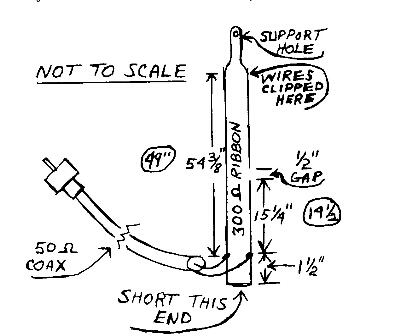|
A Neat Antenna That Works Like a Charm and Fits in Your Pocket!

Want an effective 144 MHz antenna you can roll up to fit in your pocket and yet, when extended, checks out as good as a 5/8 wave? How about one that costs next to nothing to construct? One that requires little or no technical skill; just the ability to measure, trim, and solder?
The configuration is great for hanging from the ceiling of motels and for quickly setting up commo practically anywhere.
I used one successfully at a Cocoa Beach tennis court several years ago when the IRARC supported a benefit tournament. Using a piece of string and a thumb-tack, it was hung from a rafter in a picnic pavilion near the courts. It worked perfectly into a repeater 18 miles away.
If you can decipher the drawing above, you are in business. Note that all you really need is about 68 inches of 300 ohm twin lead and a short piece of coax line on which to connect it.
Short out one end of the twin lead keeping the wires as short as practicable. Tie in a coax line of random length 1 and 1/2 inches above the short and cut a 1/2 inch gap 15 and 1/4 inches above the shield connection. Finally, cut both wires of the twin lead 54 and 3/8 inches above the splice. Presto! You have a pretty decent 2 meter sky wire.
Most readers will recognize this assembly as another version of the simple, reliable "J" configuration. I have put together at least three of these antennas and the dimensions conformed to those shown in the drawing. The VSWR did not exceed 1.5 to 1 anywhere in the 2 meter band. To avoid drastic detuning and resultant adverse changes in the gain and VSWR, one should refrain from placing the antenna too close to other objects.
Note also that the type of twin lead used has a definite effect on the measurements. For the dimensions given in the sketch, it is imperative that the thin, inexpensive type twin lead be used. Ours was B-75 made by Gemini Industries and purchased at K-Mart. We tried using the heavy duty 300 ohm foam lead and found that different dimensions were necessary.
Just in case someone has the heavy, foam stuff on hand, the dimensions we found necessary for this type lead are shown encircled in the above drawing.
(The foregoing article by Dixpix appeared in the October, 1991 edition of Spurious Emissions, the IRARC newsletter.)
If our readers have not seen the humorous article with regard to the "Holes in the ionosphere", I recommend you click on the "Back" button below. The "Ahead" button will take you to a discussion of graphology as it relates to Ham Radio Operators.
|